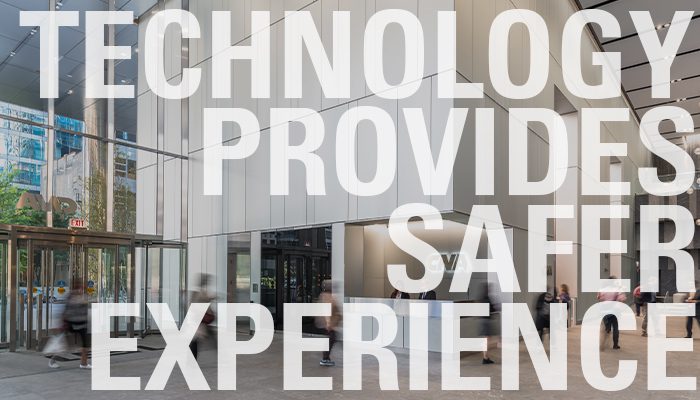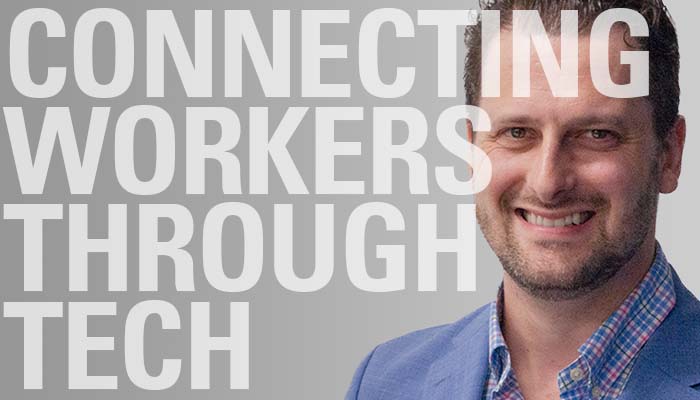The evolution of the modern office needs to accommodate team members meeting in person and online. ESD now Stantec Senior Audio Visual Consultant John Doyle offers an overview of the best technology to consider. (Learn more about the meeting room technology.)
Safety first is a statement that will always ring true – but it is ringing louder than ever in our current climate.
Transparency, Confidence, Health and Wellness – these are four words we hear more frequently today when discussing the future of workplace. Along with safety, all have become the five pillars of commercial real estate transformation.
As we reimagine the workplace and contemplate the evolution of our cities and the entire built environment, let’s not overlook a major element of the evolving hybrid-workplace and workforce model: the building lobby.
When we emerge from our prolonged work-from-home state, the first impressions of our future spaces will be that of our lobbies. As Gensler points out, lobbies are the first line of defense in preventing the spread of infectious germs. To make a compelling case for reentry, recovery and the future of the workplace in a post-vaccine world, these five pillars must start as soon as the occupant steps foot through that first door.
What will the Lobby of the Future look like? Beyond the grand entrances, the floor-to-ceiling glass, the minimalist modern reception desks and the marble floors that we became accustomed to in Class A office buildings and that leave the striking first impression, how will owners and operators make a new impression on the occupant’s first step back into the Next Normal? An impression that transforms fear and instills trust?
Enter Digital Transformation.
Bridging the physical and digital worlds by leveraging Smart Building technologies and unleashing the power of data is no new trend in the built environment. However, a majority of owners and operators have been hesitant in deploying these technologies, as many wanted to avoid being the first to pilot new solutions, and others just couldn’t make the business case for what was perceived as convenient experiences. Today this pandemic is not only accelerating innovation in the Smart Building and Proptech industries, but also making the most essential business case for all – Occupant Safety.
While short term we will be greeted by ad hoc solutions such as stand-alone thermal screening stations, siloed pop up digital kiosks, sanitation stations, extensive decals throughout, and security personnel directing traffic from a far, the not so distant horizon paints a more promising and welcoming picture. With the rapid evolution of IOT and building sensors, shift of software, platforms, and infrastructure elements into the cloud and into an as a service “XaaS” model, hyper-connectivity as well as convergence of systems – building technologies are becoming omnipresent, pervasive, and less obtrusive.
From door to desk, expect a seamless experience that transcends convenience and operational efficiency by eliminating common touchpoints and superfluous physical collisions, from automated pre-arrival visitor registration, digital check-in and seamless access through mobile digital credentialing, to touchless biometric scanning and facial recognition. Expect to be greeted by autonomous robotic security that will also serve as a digital concierge helping optimize traffic, detect anomalies within the space, scan for temperature and share personalized wayfinding guides for real time routes. Connected IOT sensors will help measure and verify indoor air quality, determine people density, identify space usage and occupant circulation providing historical usage patterns and real time data for space optimization, wayfinding, dynamic facility cleaning, and automated maintenance scheduling. Expect facility staff to also be augmented with autonomous robotic cleaning, allowing for instantaneous sanitization deployment for when and where needed.
While out of the occupant’s sight but at the fingertips of the operator, a digital twin evolution of the building platform will power the core of future buildings, converge systems and data, drive sensors and solutions, and connect the user to a digital experience that not only drives building efficiency, reduces operational costs and energy, provides on-demand conveniences, but delivers on all five pillars of real estate transformation.
So the next time we step foot into a future building lobby uncertain what may lay ahead, know this – technology is not only making your visit conveniently efficient, but its helping keeping you safe.
Want to know more? If you would like further assistance in better understanding the future of building lobbies, reach out to Mo Fahim.




